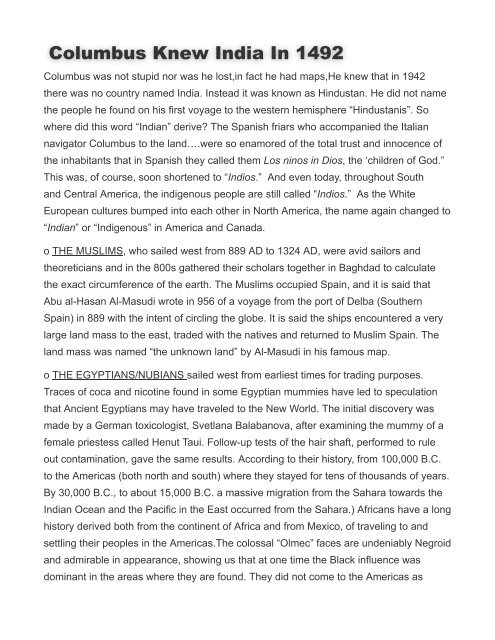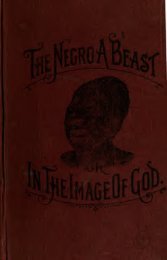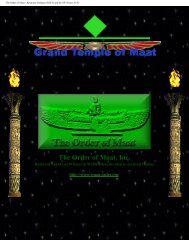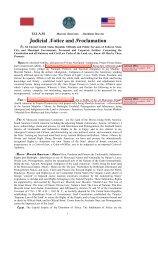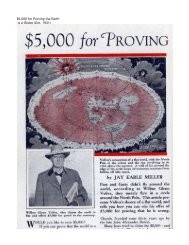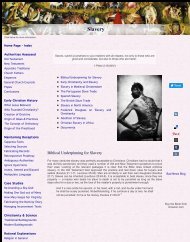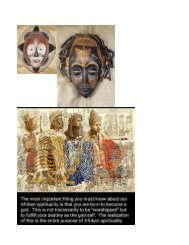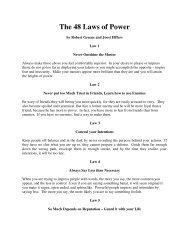Columbus Knew India In 1492
Create successful ePaper yourself
Turn your PDF publications into a flip-book with our unique Google optimized e-Paper software.
<strong>Columbus</strong> <strong>Knew</strong> <strong><strong>In</strong>dia</strong> <strong>In</strong> <strong>1492</strong><br />
<strong>Columbus</strong> was not stupid nor was he lost,in fact he had maps,He knew that in 1942<br />
there was no country named <strong><strong>In</strong>dia</strong>. <strong>In</strong>stead it was known as Hindustan. He did not name<br />
the people he found on his first voyage to the western hemisphere “Hindustanis”. So<br />
where did this word “<strong><strong>In</strong>dia</strong>n” derive? The Spanish friars who accompanied the Italian<br />
navigator <strong>Columbus</strong> to the land….were so enamored of the total trust and innocence of<br />
the inhabitants that in Spanish they called them Los ninos in Dios, the ‘children of God.”<br />
This was, of course, soon shortened to “<strong>In</strong>dios.” And even today, throughout South<br />
and Central America, the indigenous people are still called “<strong>In</strong>dios.” As the White<br />
European cultures bumped into each other in North America, the name again changed to<br />
“<strong><strong>In</strong>dia</strong>n” or “<strong>In</strong>digenous” in America and Canada.<br />
o THE MUSLIMS, who sailed west from 889 AD to 1324 AD, were avid sailors and<br />
theoreticians and in the 800s gathered their scholars together in Baghdad to calculate<br />
the exact circumference of the earth. The Muslims occupied Spain, and it is said that<br />
Abu al-Hasan Al-Masudi wrote in 956 of a voyage from the port of Delba (Southern<br />
Spain) in 889 with the intent of circling the globe. It is said the ships encountered a very<br />
large land mass to the east, traded with the natives and returned to Muslim Spain. The<br />
land mass was named “the unknown land” by Al-Masudi in his famous map.<br />
o THE EGYPTIANS/NUBIANS sailed west from earliest times for trading purposes.<br />
Traces of coca and nicotine found in some Egyptian mummies have led to speculation<br />
that Ancient Egyptians may have traveled to the New World. The initial discovery was<br />
made by a German toxicologist, Svetlana Balabanova, after examining the mummy of a<br />
female priestess called Henut Taui. Follow-up tests of the hair shaft, performed to rule<br />
out contamination, gave the same results. According to their history, from 100,000 B.C.<br />
to the Americas (both north and south) where they stayed for tens of thousands of years.<br />
By 30,000 B.C., to about 15,000 B.C. a massive migration from the Sahara towards the<br />
<strong><strong>In</strong>dia</strong>n Ocean and the Pacific in the East occurred from the Sahara.) Africans have a long<br />
history derived both from the continent of Africa and from Mexico, of traveling to and<br />
settling their peoples in the Americas.The colossal “Olmec” faces are undeniably Negroid<br />
and admirable in appearance, showing us that at one time the Black influence was<br />
dominant in the areas where they are found. They did not come to the Americas as
slaves, but as settlers and even lords. It is claimed that they settled islands in the Atlantic<br />
and remained there over the centuries, long before Black slaves were brought to the<br />
Americas. It is certain that ancient Africans visited the Americas from about 3,000 B.C.,<br />
staying and building cities. I is believed that a massive group of Blacks left the Sahara,<br />
moving towards the <strong><strong>In</strong>dia</strong>n Ocean and the Pacific, then going even further to the East,<br />
across the Atlantic. Blacks continued to cross the Atlantic to the Americas from that time<br />
on, until the time of <strong>Columbus</strong>' first voyage.<br />
THE WASHITAW (Ouachita) People have an oral history of seafaring trade between the<br />
Americas and Africa. And it is claimed that the Washitaw are in origin an aboriginal Black<br />
nation. The original settlers of the Mississippi Valley region, the former Louisiana<br />
Territories and parts of the Southern United States were these peoples. According to oral<br />
traditions, their ancient ships, on missions of trade and commerce, frequently plied the<br />
Ocean between Africa and the Americas. <strong>In</strong> 1964, the <strong>In</strong>ternational Congress of<br />
American Anthropologists was held in Barcelona, Spain. A French anthropologist<br />
claimed that Negroid skeletons were needed, in addition to the already found Negroid<br />
featured terracottas, to prove there were Blacks in the Americas before <strong>Columbus</strong>. <strong>In</strong><br />
February of 1975, skeletons of Negroid people dating to the 1200s were found at a pre-<br />
Columbian grave in the Virgin Islands. Andrei Wierzinski, craniologist, concluded that a<br />
good portion of the skulls were that of African Blacks, and that Negroid skeletons had<br />
been found throughout Mexico. Mexican professionals conclude that Black Africans<br />
established early trading centers on the coasts of the Americas, beginning at Vera Cruz,<br />
from which Meso-American civilization grew. If we can believe the general consensus of<br />
contemporary scientific studies, Blacks continued to migrate from their homeland in<br />
Africa to settle throughout Asia, Europe, Australia and the Americas.


